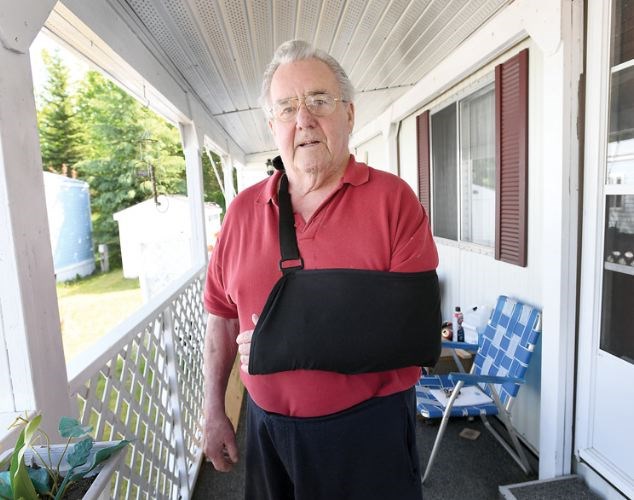A Prince George man with an injured shoulder that causes him bouts of excruciating pain was told he had to wait nearly 800 days for a diagnostic MRI.
Roy Smith, 77, couldn't believe it when he got the call May 30 that told him the magnetic resonance imaging procedure was scheduled at UHNBC for Aug. 8, 2019.
"So I get a phone call," Smith said. "They've got me a date. They said Aug. 8, I said 'oh, that's good.' She said 'no it's not, it's 2019.' I said 'you're kidding me' and she said 'I don't kid about things like this.'"
Not wanting to wait 793 days, Smith made another appointment to see his doctor Monday morning, hoping to see if he could be moved up.
"I told him I was in excruciating pain and I couldn't stand it any longer," Smith said.
That very afternoon, he got another call from the MRI scheduling office.
"I got another appointment," Smith said. "It's on Nov. 15, 2017. That's not too bad. I can wait 'til then."
Smith injured his left shoulder by simply using his arms to help him get out of a chair one day last September.
"I heard a cracking and tearing sound," Smith recalled. He thought he pulled a muscle and the pain kind of went away so he didn't bother with it.
"A couple of weeks ago it came up really bad."
His arm from the shoulder right to halfway down his knuckles was black.
"It left me in really bad pain," Smith said, who spent the night in hospital as a result May 10.
"Then on Friday, May 12, I called 911 again."
This time not only is his arm black but along the side of his body, too.
"The doctor suggested that I get an MRI," Smith said.
"I didn't get one."
He was sent home again.
His arm went back to its normal colour by May 20 but he was still having lots of pain, he added. He uses a sling to keep his arm immobile and he needs to lift his arm with his other hand to move it.
"The pain is like a nagging toothache and then a couple of times a day it flares up for about an hour or so and then it feels like someone's sticking pins into the joint," Smith said.
He went back to his family doctor who ordered the MRI.
The University Hospital of Northern B.C. in Prince George just got a brand new MRI in February worth $2.86 million.
An MRI uses a magnetic field and radio waves to see detailed images of muscles, ligaments, cartilage and other joint structures, which is better than an X-ray, ultrasound, or CT scan, explained a Northern Health press release dated Feb. 9, 2017.
When the news of his appointment date sank in for Smith, he was upset to hear how long he had to wait.
"I'm 77 now and I'll be 80 by the time I get it done," Smith said.
"And that's just the MRI. Just to see what the surgeon has to do."
Before finding out his date had been moved up, Smith had looked at other alternatives to have it done privately, which means at his own cost. After making some calls of inquiry, he learned if he went to Vancouver the MRI would have cost him more than $2,000 and in Dawson Creek the cost quoted to him was $1,500. He considered it.
Northern Health recognizes that wait lists for MRI are long, Eryn Collins, communications officer said.
"That is why we are quite excited to have three new MRI machines coming online this year, one of which is already operational at UHNBC," Collins said.
"The other two are going into Terrace and Fort St. John. Both of those construction projects are underway."
Terrace's MRI will see patients being diagnosed in the summer, while in Fort St. John the date is late summer, early fall, she added.
"That will see some MRI procedures scheduled for here repatriated back to those regions and that will add capacity in UHNBC and should significantly bring those wait lists down," Collins said.
"We will now have three MRI referral points in the north as opposed to just one."
Currently there are 6,000 MRI procedures done at UHNBC each year and the forecast is an increase to 7,000 annually. Both the Terrace and Fort St. John MRIs are slated to see 2,000 procedures each in their first year of operation, with room for growth if required, Collins said.



